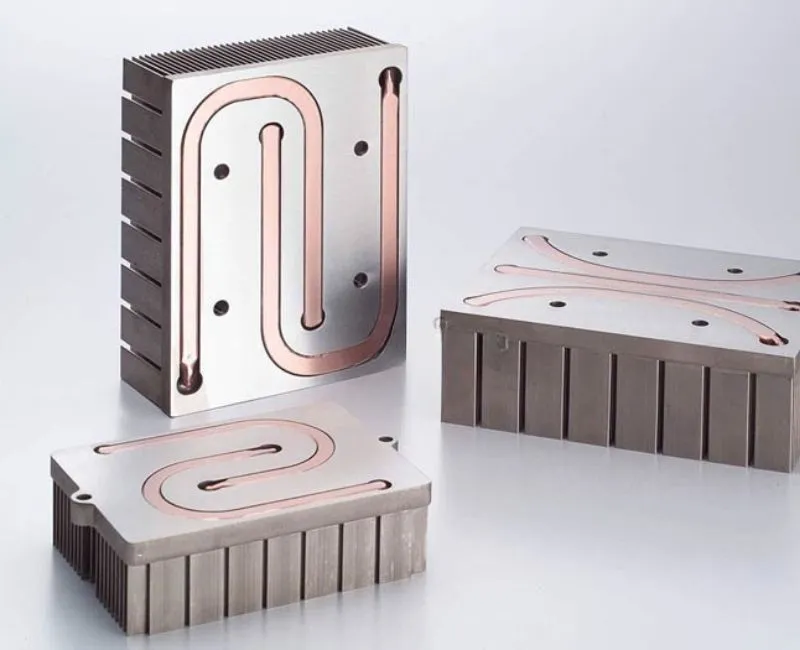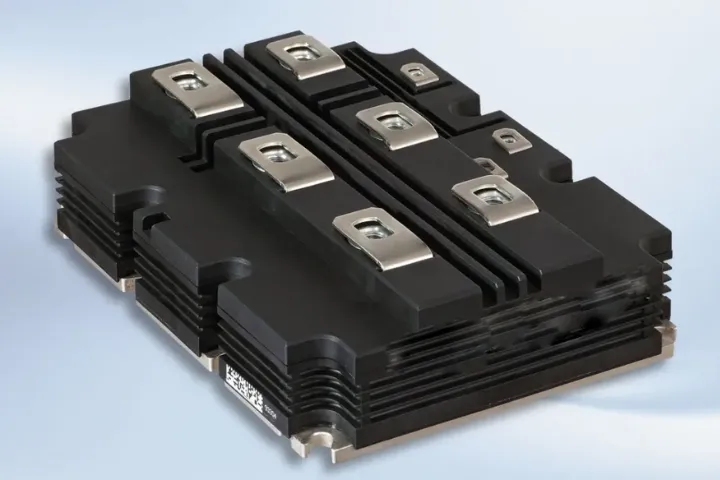Introduction
You open your laptop after a long day and feel it sizzle. You wonder what keeps that CPU cool—and what secret liquid pulses through tiny pipes inside. Imagine if that fluid fails. You’d face crashes, lost work, even hardware damage. We’ll show you how heat pipes stop that from happening.
Heat pipes contain a small amount of specially chosen working fluid—most often purified water under vacuum—that evaporates at the hot end, carries heat as vapor, then condenses back to liquid at the cool end, repeating this cycle to move thermal energy with extreme efficiency.
Curious how a few drops of liquid can cool that powerful chip? You’re not alone. Let’s explore what’s inside and why it matters.
Understanding Heat Pipes & How They Work
What Exactly Is a Heat Pipe?
A heat pipe is a sealed metal tube—usually copper or aluminum—that transfers heat with almost no temperature drop. Inside, you find three key elements: a tiny amount of working fluid, a capillary wick lining the inner wall, and a vacuum.

- Envelope: The outer shell that holds fluid, wick, and vacuum.
- Working Fluid: Liquid that evaporates to carry heat.
- Wick Structure: Pores or grooves that pump liquid back via capillary action.
- Vacuum: Lowers boiling point and prevents air from blocking flow.
The Phase‑Change Cycle in Detail
Heat pipes work by cycling fluid between liquid and vapor:
- Evaporation (Evaporator Zone): Heat enters the pipe’s hot end. The fluid absorbs this energy and boils, turning into vapor.
- Vapor Transport (Adiabatic Section): The vapor travels through the vacuum‑filled core toward the cooler end, carrying latent heat.
- Condensation (Condenser Zone): At the cool end, vapor releases energy and condenses back to liquid on the inner wall.
- Liquid Return (Wick): The liquid wets the wick and returns to the evaporator by capillary action, ready to repeat the cycle.
Wick Types and Their Roles
Different wick designs optimize performance under various conditions:
- Sintered‐Powder Wick: Porous structure with high pumping power—works in any orientation.
- Grooved Wick: Machined V‑grooves—simple, robust, but gravity‑assisted orientation performs best.
- Screen Mesh Wick: Layers of fine wire mesh—balanced capillary action and flow resistance.
Choosing the right wick depends on operating angle, required heat load, and fluid viscosity.
Orientation and Gravity Effects
Heat pipes can operate horizontally or vertically, but gravity influences liquid return:
| Orientation | Liquid Return | Performance Impact |
|---|---|---|
| Gravity‑Aided (Cond. above Evap.) | Assisted by gravity | Highest heat transport |
| Horizontal | Capillary‑only | Moderate performance |
| Against Gravity (Evap. above Cond.) | Only capillary | Lower maximum heat flux |
Typical Performance Metrics
Key figures you’ll see in heat pipe specs:
- Effective Thermal Conductivity: 20,000–100,000 W/m·K (compare to copper’s ~400 W/m·K).
- Maximum Heat Flux: 10–100 W/cm² depending on wick and fluid.
- Temperature Drop: Often less than 5 °C across a 200 mm pipe at rated load.
Real‑World Examples
In a gaming laptop, you might see a pair of ⌀6 mm copper/water pipes moving 50 W each from the CPU to a fin array. In satellites, ⌀10 mm aluminum/ammonia pipes redistribute hundreds of watts from sun‑lit panels to radiators. These real cases show how design choices—diameter, fluid, wick—match application needs.
What Are Heat Pipes Filled With? (Common Working Fluids)
Heat pipes typically contain a small amount of a specially selected working fluid—most often purified water under vacuum—because it offers high latent heat and non‑toxicity. In colder environments, fluids like ammonia or methanol replace water. For niche applications, engineers use refrigerants (R‑134a), organic solvents (acetone), or even liquid metals (sodium, potassium) to match extreme temperature needs.
Choosing the right working fluid is critical because it directly affects a heat pipe’s operating range, efficiency, and safety. Each fluid boils and condenses at specific temperatures under vacuum, so engineers match the fluid’s phase‑change properties to the device’s thermal profile. Below, we break down the most common fluids and why they’re used.
Water (H₂O)
- Why water? Highest latent heat of common fluids (≈2,260 kJ/kg), so it carries more energy per cycle.
- Temp range: ~30 °C to 250 °C under vacuum.
- Advantages:
- Non‑toxic and abundant
- Low cost and easy to source
- Excellent heat transfer for electronics (CPUs, LEDs)
- Limitations: Freezes below 0 °C—pipes may be damaged if exposed to deep cold without proper headspace.
Ammonia (NH₃)
- Why ammonia? Low boiling point (–33 °C) allows operation in sub‑zero and aerospace environments.
- Temp range: ~–70 °C to 100 °C.
- Advantages:
- Effective in satellites, cold‑climate equipment
- High latent heat nearly on par with water
- Limitations: Toxic and corrosive—requires robust containment and professional handling.
Alcohols (Methanol & Ethanol)
- Methanol (CH₃OH):
- Temp range: –40 °C to 110 °C
- Low freezing point—ideal for cold‑start electronics
- Flammable—needs careful sealing
- Ethanol (C₂H₅OH):
- Temp range: –10 °C to 120 °C
- Higher boiling point than methanol
- Used in specialized sensors and lab devices
Refrigerants & Organic Solvents
- R‑134a: Boils at ≈ –26 °C under vacuum; common in HVAC “heat pipes” and dehumidifiers.
- Acetone: Boiling point ≈56 °C; used in thermal test rigs for quick phase change.
- Other solvents: Toluene, propane for niche solar‑thermal or lab applications.
Liquid Metals (Sodium, Potassium)
- Why metals? Extremely high boiling points and latent heat—suitable for 400 °C to 1,000 °C+.
- Common uses: Industrial furnaces, nuclear reactors, high‑temp calibration equipment.
- Drawbacks: Reactive and hazardous; only for specialized industrial or scientific setups.
Comparison Table of Common Working Fluids
| Fluid | Temp Range (°C) | Key Benefits | Main Drawbacks |
|---|---|---|---|
| Water | 30 – 250 | High heat capacity, safe, low cost | Freezes below 0 °C |
| Ammonia | –70 – 100 | Works in sub‑zero, aerospace | Toxic, corrosive |
| Methanol | –40 – 110 | Low freezing point | Flammable |
| Ethanol | –10 – 120 | Moderate range | Flammable |
| R‑134a | –26 – 80 | HVAC, dehumidifiers | Special handling |
| Liquid Metals | 400 – 1,000+ | Ultra high‑temp | Reactive, hazardous |
Each fluid offers unique advantages. If you need help selecting the perfect working fluid for your next thermal project, contact Kenfatech today for expert guidance.
Why These Fluids? Design & Selection Criteria
Vacuum Sealing & Boiling Point Control
- Create Low Pressure: Manufacturers evacuate air to ~10⁻³ Torr. This vacuum lowers boiling points by 50–70 °C, so water can vaporize around 30–40 °C instead of 100 °C.
- Precise Fluid Dose: Only 10–30% of interior volume is filled with liquid—just enough to wet the wick but leave headspace for vapor expansion.
- Hermetic Seal: Pipes are seam‑welded or soldered shut to prevent leaks and air ingress over decades of operation.
Matching Fluid to Temperature Range
Engineers choose fluids whose phase‑change ranges align with device operating conditions:
- Water: Ideal for 30 – 250 °C devices like CPUs, heat sinks, LED arrays.
- Methanol/Ammonia: Used when ambient or startup temps fall below 0 °C (methanol to –40 °C, ammonia to –70 °C).
- Liquid Metals: Required for extreme heat sources above 400 °C (e.g. industrial furnaces, reactors).
Heat of Vaporization & Efficiency
- High Latent Heat:
- Water: ~2,260 kJ/kg
- Ammonia: ~1,370 kJ/kg
- Methanol: ~1,100 kJ/kg
- Energy Transport: Fluids with higher latent heat move more energy per gram, reducing the pipe’s required diameter and improving overall system compactness.
Chemical Compatibility & Stability
- Material Pairing:
- Water + Copper: Best corrosion resistance and thermal performance.
- Ammonia + Aluminum: Prevents corrosion in aerospace tubes.
- Liquid Metals + Stainless/Superalloys: Handles high temp without reaction.
- Long‑Term Purity: High‑grade fluids and clean filling processes avoid contaminants that can produce non‑condensable gas and degrade performance.
Wick Design & Fluid Return
- Optimal Fill Level: Fluid saturates the wick (30–50% porosity) so vapor space remains unobstructed.
- Custom Wick Structures:
- Sintered Powder: High capillary pressure for any orientation.
- Grooved Channels: Lower resistance, gravity‑assisted return.
- Mesh Screens: Balances capillary action and flow resistance.
- Performance Impact: Proper wick ensures liquid returns swiftly, preventing dry‑out even at high heat flux (50–100 W/cm²).
Selection Criteria Overview
| Criterion | Description | Why It Matters |
|---|---|---|
| Boiling Point | Temperature at which fluid vaporizes under vacuum | Ensures phase change occurs within device’s operating range |
| Latent Heat | Energy per kg required to vaporize | Higher values move more heat per gram, boosting efficiency |
| Chemical Stability | Resistance to breakdown over cycles | Maintains performance and prevents gas formation |
| Compatibility | Non‑reactivity with envelope and wick materials | Avoids corrosion, extends lifespan |
| Safety & Toxicity | Flammability, toxicity levels | Ensures safe handling and end‑use applications |
| Viscosity | Fluid’s flow resistance | Affects capillary return speed and dry‑out risk |
If you need help selecting the optimal working fluid or designing heat pipes for your application, contact Kenfatech’s experts now.
Frequently Asked Questions about Heat Pipe Fluids
Q1: Do heat pipes ever leak or need refilling?
No. Heat pipes are hermetically sealed, so they never leak or need fluid top‑ups. Only a puncture or severe bend can break the seal. Even then, you’ll find just a few drops of fluid soaked in the wick, not a flood.
Q2: What is the liquid in my PC’s heat pipes? Is it water?
Yes. Most modern PC and laptop heat pipes contain distilled, deionized water under vacuum. That water handles typical CPU and GPU temps perfectly. A few niche products might use alcohol blends, but water remains the top choice for consumer electronics.
Q3: Can the fluid inside a heat pipe freeze in cold weather?
Water‑filled pipes can freeze if temperatures drop below 0 °C, but manufacturers leave headspace to prevent burst. On warming up, ice melts and the pipe works normally. For extreme cold, we swap in fluids like methanol or ammonia that won’t freeze at low temperatures.
Q4: Is the working fluid hazardous or toxic?
Not in most devices. Consumer heat pipes use water or small alcohol amounts, both sealed and non‑toxic. Industrial or aerospace pipes may house ammonia or liquid metal, but those get handled only by trained professionals.
Q5: How long do heat pipe fluids last? Do they wear out?
They last for decades. The fluid stays in a closed loop, cycling endlessly. A quality heat pipe sees thousands of cycles with no fluid loss. Some performance loss can occur after many years, but generally a heat pipe outlives the device it cools.
Conclusion & CTA
Wrapping It Up
Heat pipes rely on carefully chosen fluids—water, ammonia, alcohols, or even metals—to move heat with unmatched efficiency. Their secret lies in phase change and smart design, keeping your devices cool without extra power or moving parts.
Ready to Get Started?
If you need expert thermal design or custom heat pipes for your project, contact Kenfatech today. Our team will help pick the right fluid and structure to meet your performance and reliability goals.



